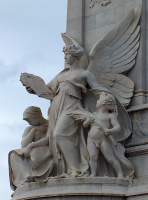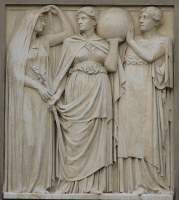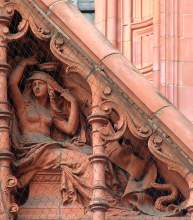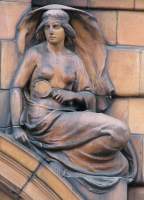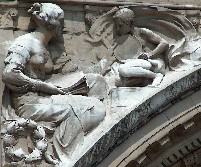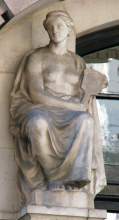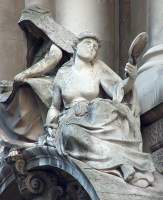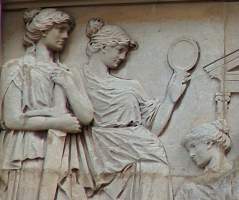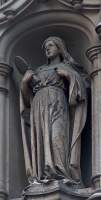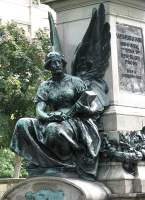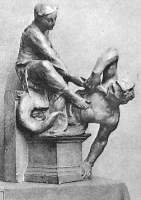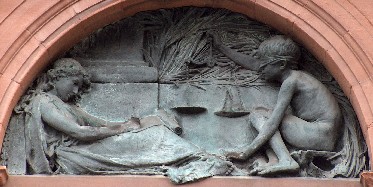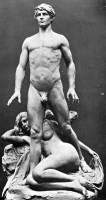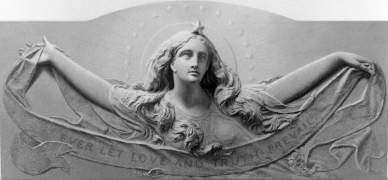An Alphabet of Allegorical Sculpture - T is for Truth
Allegorical statues of Truth are widespread, typically found as architectural sculpture on buildings connected with the law, as well as appearing as an attribute of great historical personages, and as stand-alone ideal figures.
Truth is almost always female, and is most often an ideal figure, not particularly muscular, bare-breasted and with a long skirt. She may have a cloak over her shoulders too, and may be pulling a cowl from over her face unveiling the Truth, as in the lefternmost figure in the panel below. This work is one of several panels by Stirling Lee decorating Liverpool's St George's Hall.
Stirling Lee's Truth (left hand side).
Unveiling is also suggested in the two seated figures below, both in terra cotta. To the left is Harry Bates's exquisite Truth as Cleopatra (a moment of Truth when she realises she is doomed to fall to the Romans and decides to kill herself witness the snake on the right - the snake itself is sometimes used as an accoutrement of Truth, as the snake may be a representation of Wisdom, as in clear sight, hence Truth). Her one hand is drawing aside her cloak, her other reaching for a lamp, another symbol of Truth (Truth revealed in the light). The figure to the right is in Manchester, on the Coroner's Court and Fire Station, who has a cloak or cowl swirling above her head as if caught by the wind. The artist is J. J. Millson.
Figures of Truth in Birmingham and Manchester.
The Manchester figure above introduces us to Truth's most familiar symbol - the mirror. Here it is small and round, a mirror to see one s own reflection in, and the reality contained therein. This is the most common type, but Brock s huge Angel of Truth at the top of the page, on the Victoria Memorial in front of Buckingham Palace, has a much larger mirror which she props against her hip. A mirror like that could slay a gorgon.
More with mirrors. Below left, a spandrel figure of Truth looking at a polished plate held by a young boy. She also holds a book, another symbol of Truth, either as a volume in which to record the Truth, or a Bible on which to swear it. This winsome creature is by George Frampton, and is on the front of the V&A. And to the right is one by another New Sculptor, F. W. Pomeroy, alas in soft stone and rather exposed, so very worn, on the front of the Central Criminal Court, Old Bailey. Between these two, central below is a rectangular mirror held by a very Classical Truth, by Charles Pibworth, not far from Pomeroy's one, in Chancery Lane.
Versions of Truth by Frampton, Pibworth, Pomeroy.
Three more chaste examples below, fully clothed standing figures, each with a round mirror. Two are classical, but the one on the right is an example of a Medieval-style figure, with her long, hanging sleeves, square-cut upper garment and hooded cloak. The Baroque setting would have allowed equally for a classical figure.
More Truth and mirrors.
Below, another Angel of Truth, again by Brock, in St John s Gardens, Liverpool, as an accessory figure to the Gladstone Monument. Characteristic of Brock, this Valkyrie-like figure is no slight maiden, but a muscular character. She carries a book rather than a mirror.
Truth for the Gladstone Monument, Liverpool.
Here are three rather unusual examples. Below left is the model for Alfred Stevens's Wellington Monument group in St Paul s Cathedral. She is Truth overcoming Falsehood. In the centre is Truth as a young girl, recording the Truth on a scroll, accompanied by Blind Justice as a young boy. This is the work of Reynolds-Stephens. And below right, by Bertram Mackennal, is the Truth Seeker, a rare male figure, unclad and heroic. The equally nude girl he is staring away from is presumably the comforting figure the seeker after Truth must leave her grasp of the drape is thus not an unveiling, presumably, but a futile attempt to draw him back into her embrace.
Truth overcoming falsehood, as a young girl, and as a male figure (Truth Seeker).
Back to the female figure, and we should remember that by the 1900s, Truth can also be an ideal female nude. Below left is a Truth by Derwent Wood, holding a small lamp, which we have already noted as a symbol of Truth. She is a rather full-figured young lady, typical of Derwent Wood, who even has a Psyche of similar build and mass. Equally so is G. E. Wade's Truth, shown in two views below centre, balanced on heavenly spheres, with no accoutrements at all, but holding her hands outwards and upwards, to embrace the Truth. And below right is a more typical nude Truth, as a slender, girlish figure, as in Truth in Purity. This one is angelic, and holds the familiar circular mirror to her breast.
Truth as ideal nude figures.
Our end piece jumps back to mid-Victorian times, with a high relief called The Spirit of Love and Truth, a youngish girl, impossibly pure of face, with long flowing tresses of hair and a star above her forehead. She has none of our familiar accoutrements of mirror, book, lamp or veil, but her widespread arms are another example suggestive of embracing Truth, and the long ribbon and gauzy fabric of her drapery recall the idea of unveiling. Joseph Edwards was the sculptor.
Back to Allegorical sculpture - S // Onward to Allegorical sculpture - U // Full Alphabet of Allegorical Sculpture
Sculpture in England // Sculptors
Visits to this page from 4 June 2012: 16,634
